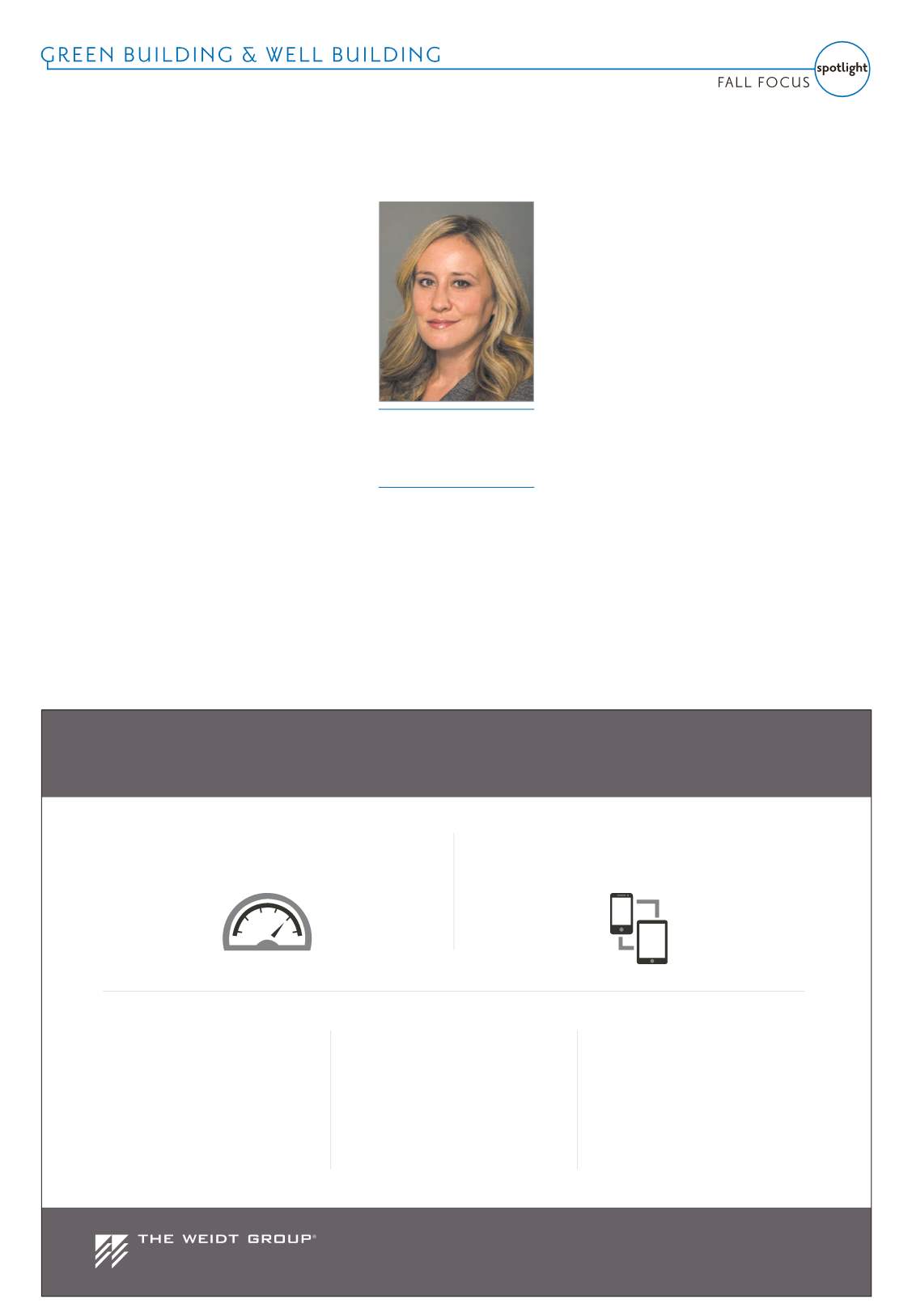
September 2-September 15, 2015
—
COLORADO REAL ESTATE JOURNAL
— Page 21B
Custom Tools
Energy design and analysis apps that
influence product sales and policy making
Building Performance
Engineering services for optimizing
existing building energy performance
The WeidtSim
®
Platform
Energy Modeling Tools to Exceed Your Goals
Demand Side Management
Energy efficiency consulting,
software and turnkey solutions
for DSM programs
500
DSM projects annually
with 250 analyses per project
Energy Design Assistance
Precise, real-time predictive
modeling for projects as
early as Day One
2,120
Projects designed using NEO®
B3 Benchmarking
Track, rank, manage &
improve every building
12,000
Public buildings benchmarked
A
s humans, we spend
90 percent of our time
indoors, including
a significant amount of time
in the working environment.
This means our physiology
is particularly vulnerable
to the built environment.
Development and even
sustainable design traditionally
has focused on the operational
efficiency and environmental
impact of the building
alone, leaving occupant
activity, mood, performance
and overall well-being and
health in the background.
Today, we know that these
development considerations
can be significant market
differentiators and have a new
system to focus specially on
occupants.
The new WELL Building
Standard prioritizes people
and is the first certification to
focus exclusively on the health
and wellness of the building’s
occupants. This framework
is the result of Delos, the
development company that
coined the “Wellness Real
Estate” term, which seeks to
merge medicine, science,
design and construction to
retool the impact our built
environment has on building
inhabitants. It also holds
organizations accountable by
requiring continual certification
and verification that facility
management is continuing with
goals established at the onset of
the project.
We are working on a local
tenant improvement project
pursuing WELL Building
Standard certification to further
understand the impact our
built environment has on users
and bring this knowledge into
practice to inform our future
design efforts. As designers,
we welcome this new guide
that prioritizes the people for
whom our designs are created
and helps substantiate this
prioritization with current,
rigorous research, resulting
in evidence-based, data-driven
design that so many of us in
the development community
strive for. This standard
applies to new construction,
major renovation, tenant
improvement and core and
shell development.
WELL is administered by the
International WELL Building
Institute, a public benefit
corporation created by Delos.
In order to achieve WELL
certification, a space must
undergo a documentation
process, in addition to an
on-site assessment and
performance testing by a third
party. The WELL Building
Standard is third-party
certified by Green Business
Certification Inc., which also
administers the Leadership
in Energy and Environmental
Design certification and LEED
credentialing program, a
sister organization of the U.S.
Green Building Council. The
WELL standard was created to
work harmoniously with the
more widely recognized LEED
Green Building Rating System,
as well as the Living Building
Challenge. The tenets of the
WELL standard, which IWBI
calls the “human architecture
interface,” is broken it into the
following sectors: air, water,
nourishment, light, fitness,
comfort and mind.
These concepts are then
linked to following body
systems, which are the
foundation of human health:
cardiovascular, digestive,
endocrine, immune,
integumentary, muscular,
nervous, reproductive,
respiratory, urinary and skeletal.
These seven concept
categories then break down
into “preconditions” and
“optimizations” (akin to LEED
prerequisites and credits) that
are instituted to varying degrees
based on different project types
and certification threshold
levels targeted. Preconditions
are what the WELL Building
Standard considers the
foundation for wellness in
the built environment. For
certification or compliance
to be awarded, all applicable
preconditions must be met.
Optimizations are features that
include optional technologies,
strategies, protocols and
designs that can be applied to
a project to qualify for WELL
certification at either the Gold
or Platinum level, depending
on the total number of
optimizations achieved.
n
Air.
The standard for
air establishes requirements
to create optimal indoor air
quality to support the health
and well-being of building
occupants, including: filtration,
ventilation, moisture control,
protection from endogenous
pollution and construction
protocols.
n
Water.
The standard for
water promotes safe and clean
water through proper filtration
and other methods, requiring
the appropriate quality of water
for various uses, including:
water quality, drinking water
access and filtration.
n
Nourishment.
The standard
for nourishment requires the
availability of fresh, wholesome
foods, limits unhealthy
ingredients and encourages
better eating habits and food
culture, including: access to
healthy foods, healthy portions,
mindful eating, sanitary prep
areas and food production.
n
Light.
The standard for
light provides illumination
guidelines that are aimed to
minimize disruption to the
body’s circadian system and
enhance productivity and
provide appropriate visual
acuity where needed. It also
requires specialized lighting
systems designed to increase
alertness, enhance occupant
Ara Massey,
LEED AP BD+C
Director of sustainability/associate,
Hord Coplan Macht, Denver


